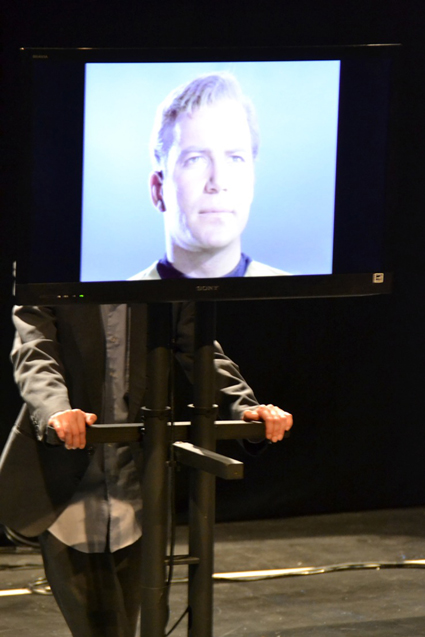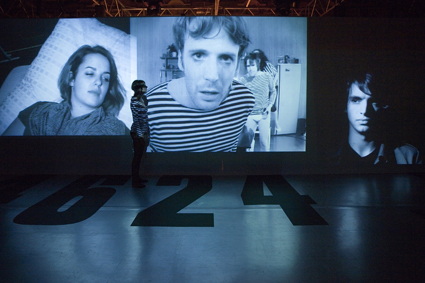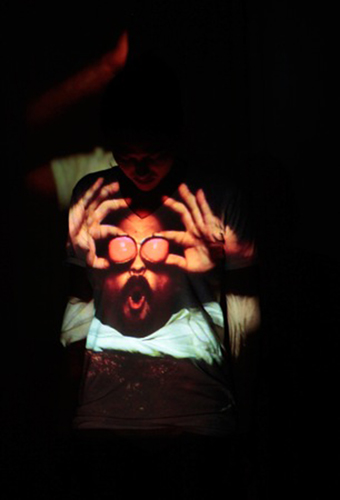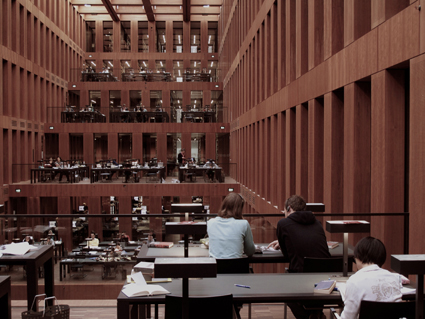You, me, the theatre: is it enough?
Alex Lazaridis Ferguson: PuSh Festival 2014, Vancouver

Phil Soltanoff, An Evening With William Shatner Asterisk
photo Shilpa Bakre
Phil Soltanoff, An Evening With William Shatner Asterisk
Leisure, writes philosopher Henri Lefebvre, is inherently alienating. Someone else manufactures an experience; you consume it. Take contemporary performance. Romanian theatre scholar George Banu says that with no gods to perform for we’re left to contemplate one another in a hall of mirrors, endlessly multiplied. There’s a lot of you and a lot of me and not a lot of anyone else.
Of course, we can look at such leisure activity as a social ritual in which we encounter one another in a specially concentrated way. Yes, we pay for the privilege, and that might reduce performance to the status of a consumer product. Such is the world we currently live in. We assign meaning through consumer choices. To this Lefebvre offers a ray of rebellious hope: despite the reproducibility of the leisure product, the body seeks “revenge” for the damage such repetitions inflict on it. It tries to make the experience mean something more than just a cultural night out.

Gob Squad, Kitchen
photo David Baltzer
Gob Squad, Kitchen
It’s hard to tell when artists are pushing against alienation and when they are surrendering to it. Gob Squad’s Kitchen (Berlin, Nottingham) begins with the audience entering through a stage-set with three playing areas: a couch, a kitchen, and a bedroom. As we travel through these, we briefly encounter the performers. We then go to our seats in the auditorium. A large screen stretches across the stage, blocking out the set. Live video feeds of the three scenes we’ve walked through are projected onto it. The actors play ‘themselves’ trying to recreate three iconic 1960s underground films by Andy Warhol—Kitchen, Screen Test and Sleep. A tension arises: the more sincere the attempt to reproduce the original films, the more Kitchen seems like parody or ironic commentary. Like Warhol, who played with the art of commodification—Campbell’s Soup cans, Marilyn Monroe’s face—Gob Squad have fun trying to make copies of his films and failing.
Actor Sharon Smith attempts to perform Screen Test, in which she must simply look at the camera and do nothing. Her creativity gets the better of her and she alters Warhol’s original intent by doing something—putting a clear plastic bag over her face as personal artistic statement. You could interpret this, following Lefebvre, as her body taking revenge on a hand-me-down parcel of culture. Her moment of authenticity is, of course, rehearsed. So how will a ‘real’ moment be found? One by one the actors replace themselves with volunteers from the audience. Eventually there are four un-trained performers standing in for the spectators. They are given headphones through which the actors feed them lines. The words come out sounding either more wooden or more spontaneous. Sometimes something surprising happens, something that momentarily breaks the conventions Gob Squad is playing with—such as a full-mouthed kiss between an actor and a spectator.
Of course, putting un-trained performers on stage has become its own convention. They stand in for us the way trained actors stand in for us. We end up in George Banu’s representational hall of mirrors with nothing to contemplate but our selves and our values. Banu calls them empty values.

Phil Soltanoff, LA Party
photo Lisa Barlow
Phil Soltanoff, LA Party
I’m not so sure about that. The game of self-reflective theatrical representation seems to me far from exhausted. In LA Party, Phil Soltanoff (New York) uses projection screens to displace image, voice, and body. Soltanoff’s screens are the faces and torsos of his actors. One actor’s face is filmed live and projected onto another’s. Actor One delivers a first person account of breaking a raw-food fast during a drug and alcohol bender. The face of the second actor, who has white tape over eyes and mouth, becomes the projection screen for the live video feed of the first actor. Actor One’s face does weird things when it appears on Actor Two’s face. Actor One is male, Actor Two is female. At times, Actor One’s hairy torso is projected onto Actor Two’s hairless torso. And there’s more: Actor One isn’t actually speaking. He’s miming words spoken by a third actor. So he becomes a screen for Actor Three’s words. But his mime-speaking face is being projected onto Actor Two’s face. Displacement upon displacement. Eventually the screens (Actor One and Two) disappear and the speaking actor finishes the show. Voice and face are localised to the speaker who becomes an embodiment of the previous disembodiments.
In An Evening With William Shatner Asterisk, Soltanoff’s other show at the festival, Captain Kirk of the original Star Trek TV series speaks to us from “the future” on two flat-screen monitors. He has come back to talk about the binary of art and science. His 1960s TV performances have been meticulously edited in such a way that he speaks sentences he never uttered during the show. Given that the editor and writer have had to excerpt Kirk speaking just a word or syllable from wherever they could, and stitch the images together to construct the sentences, the effect is visually disjointed and robotic-sounding—also humorous and fascinating. It takes effort to stay with the argument when presented in this jarring manner, but I enjoyed the challenge. And the pay-off is well worth it. A pre-recorded monologue by Mari Akita takes over the screens (as text only) for a while. Akita recounts dressing in drag and watching confused people try to fix a gender category on her. Kirk returns to explain that in the future there is no language to describe binaries such as male-female or art-science. A surprising dose of optimism. Or is it wishful thinking?

Quiet Volume, Ant Hampton & Tim Etchells
courtesy the artists
Quiet Volume, Ant Hampton & Tim Etchells
The Quiet Volume by Ant Hampton and Tim Etchells (London and Sheffield, England) offers a screen that is intimate and tactile. In a performance for two, I am led with another participant to a desk in the Vancouver public library and presented with a book. My fellow participant gets an identical book. We wear headphones. A whispering voice instructs us to open the books and read (always silently). I attend to the pages before me, some thick with text, some blank. Sometimes I’m instructed to read the other participant’s book while he leads me through the text with his finger. Sometimes I do this for him. I become enveloped by the page. Occasionally I’m instructed to look up and take in the library. After having my view conditioned by the frame of the page, it’s very strange. It’s not just the visual shift from two dimensions to three. It’s more synaesthetic than that. The timbre of the whispering voice inside my head has created its own texture and merges with the felt texture of the page. When I look up, my sight seems textured. Distance shrinks. The considerable height and width of the library are compressed by the voice that has turned my head into a small room. The library resists this compression—but not successfully, not until I take the headphones off. When I do, the world seems made of a thousand screens, and the finger of my neighbour, running over the lines, becomes a whole body, but a body that seems to grow from the finger, as if it is the words that have given shape to him.
Rabih Mroué (Beirut, Lebanon) returns to PuSh with The Pixilated Revolution, a lecture performance about camera-phones and how the immediacy of the Syrian revolution is almost instantly transmitted through social media. As Mroué lectures at a table, we contemplate, on a large screen upstage, what a camera-phone operator saw at the moment he or she was shot at, and possibly killed. Later we watch another camera eye discover a sniper just as the sniper fires on the camera holder, and kills him. The jittery phone images are contrasted with official state videos in which government cameras record President Bashar’s motorcade in carefully staged processions. These stable, stately images are made possible by the use of a tripod. Mroué likens the tripod to any other government weapon of control and intimidation, such as a rifle scope. Where the camera phone is fugitive and embodies rebellion, the tripod is an instrument used to project the state’s desired image of stability.
As is the trend in performance these days, projection screens of one kind or another are everywhere. Banu’s hall of mirrors is multiplied perhaps even beyond what he described a few years ago. He is right in saying we have nothing but ourselves to contemplate in these situations. But is this really such an existential tragedy? I seem to remember that Plato, the ‘father of philosophy’ wrote, “The unexamined life is not worth living.”
PuSh Festival, Vancouver, 14 Jan – 2 Feb; pushfestival.ca
RealTime issue #120 April-May 2014 pg. 16






